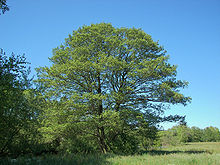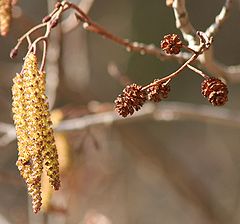- Alnus glutinosa
-
Alnus glutinosa 
Trees in native environment, Marburg, Germany Scientific classification Kingdom: Plantae (unranked): Angiosperms (unranked): Eudicots (unranked): Rosids Order: Fagales Family: Betulaceae Genus: Alnus Subgenus: Alnus Species: A. glutinosa Binomial name Alnus glutinosa
L.Alnus glutinosa (English: Black Alder, European Alder or Common Alder) is an alder native to most of Europe, including all of the British Isles and Fennoscandia and locally in southwest Asia.[1][2]
Contents
Alnus glutinosa is a tree that thrives in moist soils, and grows under favourable circumstances to a height of 20–30 m, exceptionally up to 37 m,[3] though often less. It is characterized by its 5–10 cm short-stalked rounded leaves 6–12 cm long, becoming wedge-shaped at the base and with a slightly toothed margin. When young they are somewhat glutinous, whence the specific name, becoming later a glossy dark green. As with some other plants, growing near water it keeps its leaves longer than do trees in drier situations. The glossy green foliage lasts after other trees have put on the red or brown of autumn, which renders it valuable for landscape effect. As the Latin name glutinosa implies, the buds and young leaves are slightly sticky with a resinous gum.[1][4][5][6]
There are four subspecies:[citation needed]
- Alnus glutinosa subsp. glutinosa - Europe
- Alnus glutinosa subsp. barbata - Northern Anatolia (Rize, Trabzon, Artvin); northern Iran
- Alnus glutinosa subsp. antitaurica - Southern Anatolia, rare
- Alnus glutinosa subsp. betuloides - Eastern Anatolia.
The species is monoecious. Flowers are wind-pollinated catkins: the slender cylindrical male catkins are pendulous, reddish in colour and 5–10 cm long; the female are smaller, 2 cm in length and dark brown to black in colour, hard, somewhat woody, and superficially similar to some conifer cones. When the small winged seeds have been scattered the ripe, woody, blackish cones remain, often lasting through the winter. The alder is readily propagated by seeds, but throws up root suckers abundantly.[1][4]
Important ecological relationships
Alnus glutinosa is most noted for the symbiotic relationship with the bacterium Frankia alni, which forms nodules on the tree's roots. This nitrogen-fixing bacterium absorbs nitrogen from the environment and fixes it into a form available to the tree. In return, the bacterium receives carbon which is produced by the tree through photosynthesis. This relationship, which improves the fertility of the soil environment, has established A. glutinosa as an important pioneer species in ecological succession.
A. glutinosa is also a host to a wide variety of moss and lichen. Some common species found on A. glutinosa include: Tree Lungwort (Lobaria pulmonaria), Stenocybe pullatula, and Menneguzzia terebrata.
Diseases
Alnus glutinosa is susceptible to Phytophthora alni, a recently evolved species of Phytophthora probably of hybrid origin. This is causing extensive mortality in some parts of Europe.[7]
Uses
It is important as coppice-wood on marshy ground. The wood is soft, white when first cut and turning to pale red; the knots are beautifully mottled. Under water the wood is very durable, and it is therefore used for piles. The supports of the Rialto at Venice, and many buildings at Amsterdam, are of Alder wood. It is also the traditional wood burnt to produce smoked fish and other smoked foods, though in some areas other woods are more often used now. Furniture is sometimes made from the wood, as were clogs, and it supplies excellent charcoal for gunpowder. The bark is astringent; it is used for tanning and dyeing.[5] Alnus glutinosa is also cultivated and locally naturalised in eastern North America.[1]
Seeds of Alnus glutinosa contains hirsutanonol, oregonin and genkwanin.[8]
Bonsai
The Common Alder makes a large Bonsai, a quick grower it responds well to pruning but branches can be a bit coarse and leaf size not reducing as well as the Italian Alder leaves do.[9].
Weed status
A. glutinosa is classed as an environmental weed in New Zealand.[10]
Details of Alder structure and galls
-
Black alder in Ås, Norway
References
- ^ a b c d Trees for Life Species Profile: Alnus glutinosa
- ^ Flora Europaea – Alnus glutinosa
- ^ "Spitzenbäume". Land Brandenburg. http://www.mluv.brandenburg.de/cms/detail.php/lbm1.c.189715.de. Retrieved 2009-01-19.
- ^ a b Flora of NW Europe: Alnus glutinosa
- ^ a b British Trees: Alder
- ^ Floral Images: Alnus glutinosa photos
- ^ Phytophthora Disease of Alder
- ^ Hirsutanonol, oregonin and genkwanin from the seeds of Alnus glutinosa (Betulaceae). O'Rourke Ciara, Byres Maureen, Delazar Abbas, Kumarasamy Yashodharan, Nahar Lutfun, Stewart Fiona and Sarker Satyajit D., Biochemical systematics and ecology,2005, vol. 33, no7, pp. 749-752
- ^ D'Cruz, Mark. "Ma-Ke Bonsai Care Guide for Alnus glutinosa". Ma-Ke Bonsai. http://makebonsai.com/guide/bonsailink.asp?quicklink=5052&name=Alnus_glutinosa. Retrieved 2011-7-5.
- ^ Clayson, Howell (May 2008). Consolidated list of environmental weeds in New Zealand. Wellington: Department of Conservation. ISBN 978-0-478-14412-3.
Categories:- Alnus
- Bonsai
- Flora of Europe
- Flora of the Mediterranean
- Flora of Western Asia
- Flora of Finland
- Flora of Norway
- Flora of Sweden
- Flora of the United Kingdom
- Trees of mild maritime climate
- Trees of humid continental climate
- Garden plants of Europe
- Ornamental trees
Wikimedia Foundation. 2010.










